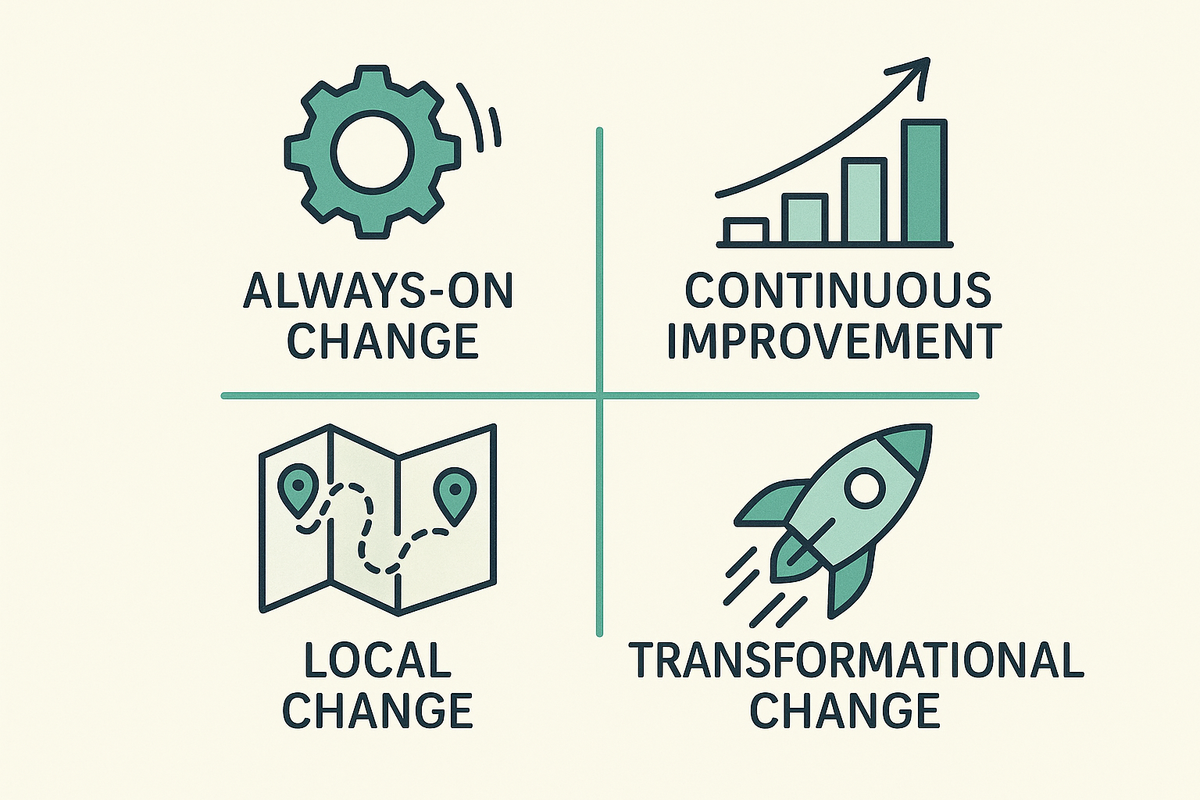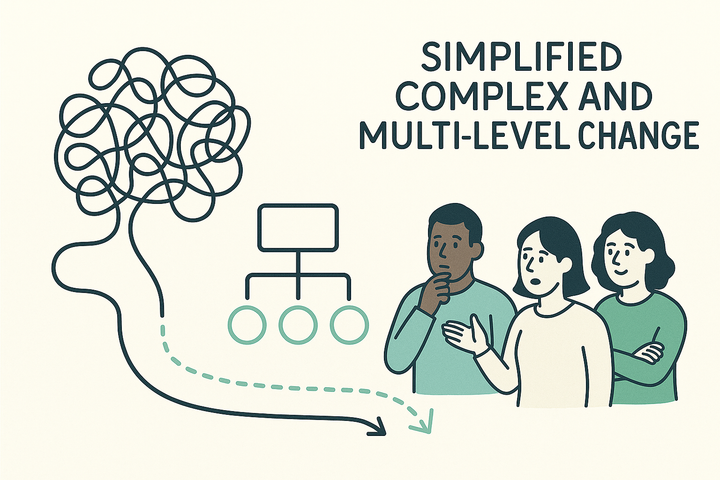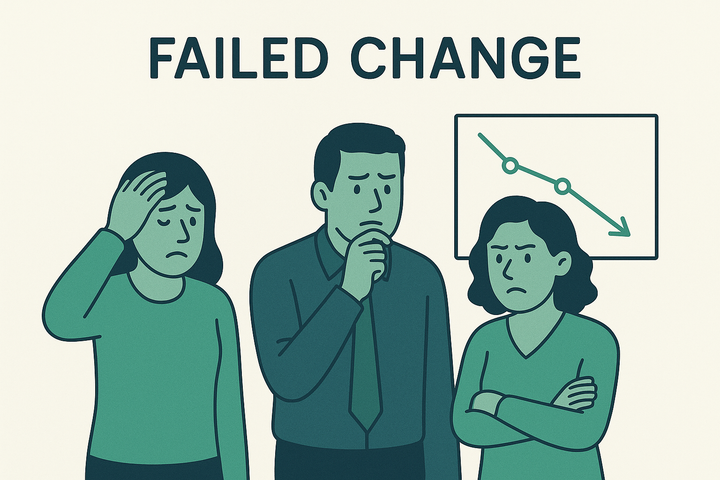The Four Types of Organisational Change and How to Communicate Them
Change fatigue has turned into change overwhelm. This article shows how to match your communication style to the scale and impact of change, using a four-part framework adapted from Balogun and Hope Hailey.

Not all change is created equal
One of the biggest mistakes organisations make is communicating every shift — big or small — as if it carries the same weight.
That’s how we ended up here: not just with change fatigue, but full-on change overwhelm.
Employees don’t experience change in neat categories. They experience how it’s handled. How it’s explained. Whether it disrupts their day or shifts their identity. And they react differently depending on how the change is framed.
Treat every minor improvement like a revolution, and people disengage. Underplay a major transformation, and they feel blindsided.
That’s why effective change communication is not just about what you say. It’s about how you calibrate your message to match the scale, pace and impact of the change itself.
The original theory (and why we’ve built on it)
This framework builds on the Balogun and Hope Hailey Change Typology, which classifies change into four categories:
- Evolutionary – Incremental, long-term change
- Revolutionary – Rapid, large-scale transformation
- Adaption – Localised or small-scale process changes
- Reconstruction – Major shifts within a fixed strategic frame
It’s a useful model for thinking strategically about change, but it doesn’t translate easily into communication practice. There’s a missing link between type of change and type of message.
So we’ve reworked the model into something more comms-friendly. Something that helps organisations make smarter decisions about when, how, and to whom they communicate.
The Four Types of Change (Through a Communication Lens)
1. Always-On Change: The constant undercurrent
This is the ambient noise of organisational life. The low-level, unlabelled changes that happen without a launch plan or a project board.
It’s the new Teams feature rolled out overnight.
The tweak to the expense form.
The dashboard layout that quietly updates.
These are the shifts that don’t seem big enough to warrant a formal message. But they affect how people work — and when they’re not explained, they create friction.
Why it feels frustrating to employees
People log in and find things have changed. No context. No heads-up. Just a small disruption they didn’t ask for.
The communication mistake
Most organisations either ignore always-on change or over-communicate it.
- Under-communicate and people feel caught off guard, wasting time trying to work out what changed.
- Over-communicate and they feel bombarded by irrelevant updates.
How to handle it
- Integrate micro-change updates into existing comms channels. No separate broadcasts needed.
- Use a “What’s New?” bulletin in weekly updates or team briefings.
- Differentiate between FYI changes (which can be made discoverable) and action-driven changes (which require visibility).
2. Continuous Improvement: Methodical, iterative upgrades
These are the intentional changes — often driven by Lean, Agile or Kaizen approaches — that aim to refine and optimise.
Examples include:
- Introducing a more efficient workflow
- Automating a manual reporting task
- Refining collaboration habits within a team
These are the slow burns that lead to meaningful progress. But only if they’re understood and supported.
The communication mistake
Organisations often get the tone wrong:
- Oversell it, and people roll their eyes. “All this noise for a minor tweak?”
- Undersell it, and they miss the fact that progress is being made. The organisation feels static, even when it’s evolving.
How to handle it
- Make the change tangible. Show the before and after. “This used to take four steps. Now it takes two.”
- Share small wins in routine updates, not flashy campaigns.
- Recognise the teams driving improvements. Communicate it as part of business as usual — not a standalone initiative.
You might also like:
- Creating a Change Narrative
- Using Metaphors in Change Narratives
- The Art of the Backstitch – Why You Need to Return and Return Again to Your Narrative
- Change and Transformation Visions – Painting the Future State
- The Four Types of Organisational Change and How to Communicate Them
3. Local Change: Significant for some, invisible to others
Local change refers to adjustments that affect a specific team, department or function — not the entire organisation. But for those affected, the disruption can be just as real as a large-scale transformation.
Examples:
- A team restructuring
- A new system for one function
- A change in line management or reporting lines
Why it’s often mishandled
Because it’s local, it’s often:
- Under-communicated to the people affected
- Over-communicated to people who don’t need to know
- Delegated to local managers who don’t have the tools to explain it properly
The communication mistake
- Broadcasting it too widely dilutes focus and adds to change fatigue
- Ignoring the emotional impact for those affected erodes trust
- Leaving it to cascade without support leads to inconsistencies
How to handle it
- Target the message precisely. Don’t flood all-staff channels with team-specific news.
- Equip local leaders with toolkits, talking points and FAQs.
- Be clear about what is — and isn’t — changing. Clarity reduces speculation.
- Treat it with the same care and respect as enterprise-level changes, just scaled appropriately.
4. Transformational Change: The big disruptors
These are the ones that shake the foundations. New strategies. Organisational redesigns. Mergers. Culture shifts. Tech overhauls.
They’re high-stakes and high-impact. They don’t just change process — they change identity, purpose and power dynamics.
The communication mistake
The biggest risk is assuming people will get on board because you’ve made a good case. They won’t.
Vision statements fall flat if people can’t see how they connect to their role.
One big town hall doesn’t build belief.
If people aren’t engaged emotionally, the transformation doesn’t take root.
How to handle it
- Start with context and meaning. Explain why this is happening before diving into the detail.
- Paint the future state. Show people what the organisation will look and feel like on the other side.
- Communicate the emotional journey, not just the logistics. Change is personal.
- Be prepared to backstitch the message — return to it again and again, through different voices and channels.
Final thought
Not all change is equal. And if you treat it like it is, your people will stop listening.
Good change communication is about calibration. About matching tone, timing and depth to the nature of what’s happening.
If you get it right, you avoid unnecessary overload. You build credibility. And you give your people the clarity and confidence they need to keep moving forward — no matter what kind of change comes next.
Not sure if your change messages are hitting the mark?
Start with the Sound & Signal Review — our straight-talking diagnostic that tells you what’s working, what’s not, and what to do next.
Or, if you’re mid-change and losing momentum, the Rapid Action Accelerator helps you get aligned, get traction and get moving again — fast.



